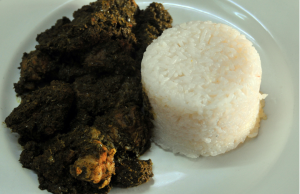Nomena’s food journey takes us to three continents, all at different points in her life. She was born in Madagascar, an island nation off the east coast of Africa, moved to France when she was 10 and finished high school, then moved to America for university before settling in Canada in 2006.
At each stage of Nomena’s global journey, she doesn’t only remember the food, she also remembers what that food meant to the culture. “In Madagascar, food was meant to be shared, not just eaten. Every meal, you always prepare for two or three extra people because you always need to be ready for someone to drop in,” she says.
That seems to be a common theme, not only in Madagascar, but across the continent of Africa. In our previous story about PK Aidoo, he mentions that Ghana has a similar tradition of sharing food at the table with extended family and friends. Folake Okusanya also told us that serving jollof rice is non-negotiable for any party in Nigeria.
When she was 10, Nomena moved to France, a completely different country on another continent. You would think the change in food would’ve been dramatic, however, Madagascar was a former French colony, so many of the foods are similar.
“There was French food everywhere [in Madagascar],” Nomena says. “That’s part of the French influence.” But despite the commonalities, Nomena does have memories of dining that were specific to her time in France.
“Some of my favourite memories growing up in France would be eating pastries. Our tradition would be to order pastries from a local bakery every Sunday,” she says.
When pressed her favourite pastries, she didn’t hesitate.“Lemon tarts,” she says immediately, “and mille-feuille. In French, mille-feuille means 1,000 layers. It’s kind of like puff pastry, but really thin with cream inside.”
How can moving to America possibly compare to French pastries? It didn’t. Nomena attended boarding school in Florida before accepting a full athletic scholarship in Texas. Those years were spent mostly eating cafeteria food, so Nomena doesn’t feel like she had the most authentic American experience when it came to food.
One thing that does stand out from her time in the U.S was the portion sizes. “It was shocking. I would go to a restaurant and only finish one quarter of the meal. Then I would bring the rest home and it made three extra meals for me.”
By the time Nomena settled in Canada and had her family, she was finally able to make her own meals. “There’s so much diversity here in Canada,” she says. “The great part is that I can get a lot of flavours from Madagascar and France in Toronto. We also embrace a lot of Canadian food, especially with the kids.”
She says her family loves bacon, but when they first moved to Canada, they had no idea what poutine was. When Nomena’s husband first saw poutine in a movie theatre, he was completely confused. “My husband comes to me and says ‘there’s this really weird place that’s serving fries with chocolate sauce,’” she laughs.
Not surprisingly, Nomena also returned to her Madagascan roots and began to re-create dishes from her native island. One of Nomena’s favourite childhood dishes from Madagascar, which she likes to recreate for her family in Canada, is ravitoto. Ravitoto is ground cassava leaves served with a fatty kind of pork and seasoned with ginger, as well as some other ingredients. Nomena says most Asian grocery stores sell ground cassava leaves, so it’s been easy to make this dish.
I hope you’re as excited as we are to try out Nomena’s recipe, and that you’ve enjoyed travelling around the world with all of our food stories.
Nomena’s Ravitoto Recipe
Ingredients:
|
Instructions:
|
The meal should be served hot. Ground cassava leaves can be found in the frozen section of some Asian supermarkets.





